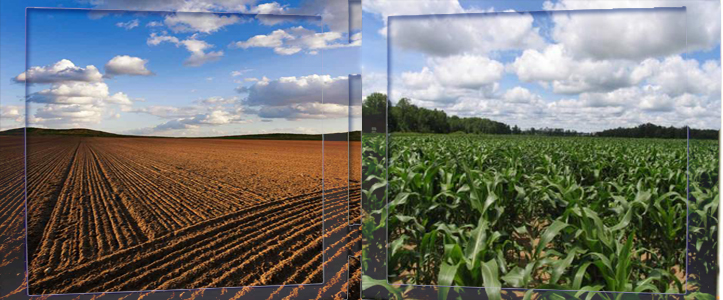Mapping Soil Fertility to
Boost Pakistan’s Agricultural Production

Agricultural sector has a
vital role in Pakistan’ economy with 21% contribution in the
gross domestic product (GDP) and employing 44% of the
country’s total employed people (25% of the total
population). Agricultural production must attain an
incessant growth in order to maintain the level of food
supplies for Pakistan’s mounting population.
Unfortunately,
agricultural production data for previous years demonstrate
a decline in production of some of the agricultural
commodities.
According to the Economic
Survey of Pakistan (2013-14) the production of cotton, one
of the major agricultural exports, declined 2% as compared
to the previous year.
USAID report on Pakistan’s
Food and Agriculture Systems affirms “the average yield of
various crops, particularly food crops, is lower than
realized elsewhere in the region.
It is significantly lower
than the average yields in the developed countries. With the
increased use of fertilizer and pesticides, the gap has
narrowed over time. Nonetheless, it is still much lower than
the potential”.
According to United Nations
Food and Agriculture Organization (FAO) the wheat
productivity in Pakistan is 2 tonnes/hectare as compared to
United Kingdom and Germany yielding 8 and 7 tonnes/hectare
respectively.
It is essential to face the
challenges of growing more food in a country such as
Pakistan where food security is crucial for poverty-stricken
people. It is estimated that until 2025, the food production
must grow by at least 40% to meet the enduring needs of 33%
anticipated augment in population.
As land is finite, escalating food production from the
limited land resources is inevitable for the survival in the
coming decades.
The intensifying population,
erratic climate and low productivity of crops pose a huge
challenge to Pakistan’s agriculture in satisfying the
country’s food demands.
Pakistani farmers have to
face numerous obstacles in managing crop production such as
lack of soil testing at farms, unavailability and poor
quality of fertilizers, wastage during harvesting, lack of
warehouses, machinery and equipment, and above all of this,
decline in soil fertility.
Agricultural experts believe
that low soil fertility coupled with lack of efficient and
sustainable soil fertility management practices is major
cause of low crop yield.
“Most of the soils in
Pakistan are deficient in plant nutrients and incapable to
support optimum levels of crop productivity” say soil
scientists.
The major nutrients needed
for plant growth are nitrogen, phosphorus, potassium, boron,
copper, iron, zinc and organic matter.
One of the major constraints
to crop production faced by smallholder subsistence farmers
is inadequate supply of nutrients. The intensive cropping
system, imbalanced use of fertilizers, unreliable irrigation
water and erosion are further depleting existing soil
nutrient reserves.
The principal indicators of
declining soil fertility are poor crop yield in climatically
good season, change in soil color and thickness, and change
in crop color.
A pragmatic and effectual tactic, to improve soil health, is
mapping soil fertility in all agricultural districts of
Pakistan. Soil fertility mapping means identifying all
aspects of soil management. Firstly, maps of soil nutrients
for delineating soils into low, medium and high nutrient
contents.
Secondly, selection of the
right fertilizer is one of the fundamental provisions as
traditional types of fertilizers such as urea and diammonium
phosphate (DAP) are not always the most effective for
different soil types.
In order to determine which
fertilizers work best for which crops and soil types, the
response of crops to different nutrient applications must be
systematically tested.
Soil fertility maps can be
used for determining and proving guidance in order to choose
what fertilizer nutrients are required for better
cultivation of crops and site-specific fertility management.
It is imperative to adapt soil-test based fertilizer use and
utilize blended fertilizers. For instance, potassium based
fertilizers in addition to diammonium phosphate and urea can
be more efficient in increasing crop production.
One of the ways to manage
appropriate supply of blended fertilizers is to install
fertilizer blending plants at district level for fabricating
blends of fertilizers to meet local soil nutrients
requirement.
The aim is to develop the
capacity of local sources to provide smallholder farmers
with a wide range of soil nutrients. For example, in
developing countries, Ethiopia has successfully implemented
soil fertility mapping and installation of plants
formulating blended fertilizers in different districts,
increasing yield of wheat up to 25%.
In order to design more appropriate research and management
programs geared to improving integrated nutrient management
practices, agricultural researchers and planners need to
understand farmer’s knowledge and perceptions of soil
fertility.
Farmers’ experimentation with
new practices is an important element of site-specific
learning that enables them to adapt the new practices to the
conditions in which they live and work.
It is of the essence for the
government to build on local systems of knowledge as they
relate to specific locations and are based on experience and
understanding of local conditions of production.
In a nutshell, to avoid importing food items, we should
generate ideas to enhance agricultural output in our own
country by relying on our own resources.
Policy intervention is
essentially required at higher levels for consolidated
operations by agricultural research, food security,
surveying and planning departments.
April, 2015
By: Dr.Atteeq Ur-Rehman
Source: Voice
of Journalists